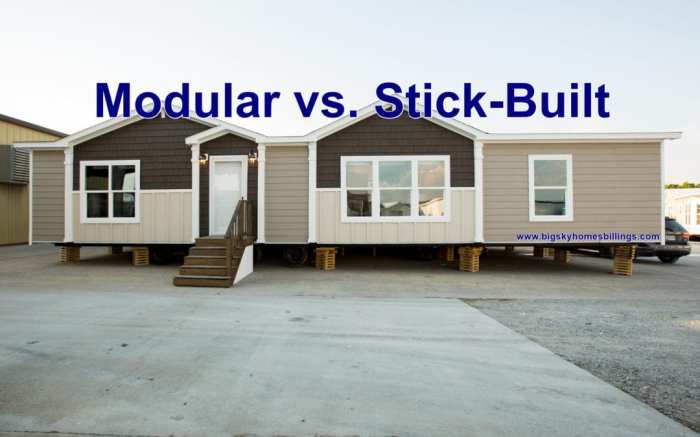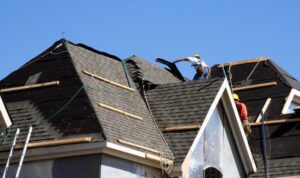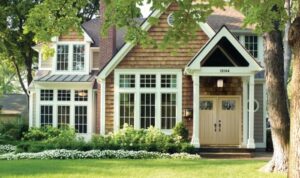Exploring the world of custom built homes vs modular homes sheds light on the unique aspects of each, offering a glimpse into the diverse options available to homebuyers. From the personalized touch of custom built homes to the efficiency of modular homes, this comparison unveils the pros and cons of each construction method.
As we delve deeper into the intricacies of custom built homes and modular homes, a fascinating journey awaits, revealing the key differences and benefits that come with choosing one over the other.
Custom Built Homes

Designing a custom-built home involves working closely with architects, designers, and builders to create a unique and personalized living space tailored to the homeowner's preferences and needs. This process allows for creative freedom and customization from the ground up.
Advantages of Choosing a Custom Built Home
- Customization: Custom-built homes offer complete freedom to design every aspect of the home according to personal style and preferences.
- Quality Control: Homeowners have greater control over the materials and construction methods used, ensuring high-quality craftsmanship.
- Unique Features: Custom-built homes can include unique features such as built-in storage solutions, custom lighting designs, and innovative floor plans.
- Personalization: From layout to finishes, every detail can be tailored to reflect the homeowner's lifestyle and taste.
Unique Features in Custom Built Homes
Custom-built homes can incorporate a wide range of unique features to enhance the functionality and aesthetics of the living space. Some examples include:
-
Smart Home Technology: Integration of advanced technology for lighting, security, climate control, and entertainment systems.
- Custom Cabinetry: Tailored storage solutions designed to maximize space and efficiency in kitchens, bathrooms, and other areas.
- Outdoor Living Spaces: Custom-designed outdoor areas such as patios, decks, and gardens that seamlessly blend with the indoor living space.
- Architectural Details: Unique architectural elements like skylights, vaulted ceilings, and custom millwork to add character and style to the home.
Modular Homes
Modular homes are constructed in factories in sections or modules, which are then transported to the site for assembly. Each module is built separately, including the walls, floors, ceilings, and other components, and then put together on the foundation at the final location.
Cost-Effectiveness of Modular Homes
Modular homes are often more cost-effective than custom-built homes due to the streamlined manufacturing process in a controlled environment. Since they are mass-produced, the materials used are typically purchased in bulk, reducing overall costs. Additionally, the assembly process is faster, saving on labor expenses.
Customization Options for Modular Homes
Contrary to popular belief, modular homes offer a variety of customization options to suit the homeowner's preferences. From choosing the layout and size of the modules to selecting finishes, fixtures, and other design elements, homeowners can personalize their modular homes to reflect their style and needs.
Design and Architecture
When it comes to design and architecture, custom-built homes offer a high level of architectural flexibility. Homeowners have the freedom to work closely with architects and designers to create a unique and personalized home that fits their specific needs and style preferences.On the other hand, modular homes come with certain design limitations or constraints due to their prefabricated nature.
While there are a variety of floor plans and styles to choose from, customization options may be limited compared to custom-built homes.
Architectural Flexibility in Custom-Built Homes
Custom-built homes allow homeowners to have complete control over the design and layout of their home. From the floor plan to the materials used, every aspect of the home can be tailored to meet the homeowner's preferences. This level of customization ensures that the final product is a true reflection of the homeowner's vision.
Design Limitations in Modular Homes
Modular homes are built in sections in a factory setting and then transported to the final site for assembly. While there are options for customization within certain parameters, such as exterior finishes and interior fixtures, the overall design is often dictated by the modular construction process.
This can result in a more limited range of design choices compared to custom-built homes.
Innovative Designs in Custom-Built and Modular Homes
Both custom-built and modular homes have seen innovative designs in recent years. Custom-built homes have incorporated sustainable features, smart home technology, and unique architectural elements to create one-of-a-kind living spaces
Examples include eco-friendly custom-built homes with passive solar design and modular homes with sleek, contemporary aesthetics.
Construction Process
When it comes to constructing a home, the process can vary depending on whether it is a custom-built home or a modular home. Let's take a look at the timeline for constructing custom-built homes and compare it with modular homes, as well as the quality control measures in place for both types of homes during construction.
Timeline for Constructing Custom-Built Homes
Building a custom-built home typically involves several phases that can span anywhere from 6 months to over a year, depending on the size and complexity of the project. The timeline can be broken down into the following stages:
- Design and Planning: 1-3 months
- Permitting and Approvals: 1-2 months
- Site Preparation and Foundation: 1-2 months
- Construction of the Structure: 3-6 months
- Interior Finishes and Final Touches: 1-2 months
Comparison with Modular Homes
Modular homes, on the other hand, are constructed off-site in a factory-controlled environment. This can significantly reduce the overall construction timeline compared to custom-built homes. The timeline for constructing a modular home typically looks like this:
- Design and Ordering: 1-2 months
- Factory Construction: 2-3 months
- Site Preparation and Installation: 1-2 months
Quality Control Measures
Both custom-built homes and modular homes have quality control measures in place to ensure that the construction meets industry standards and safety regulations. Custom-built homes may have on-site inspections at various stages of construction, while modular homes are subject to rigorous quality control checks in the factory setting.
These measures help to ensure that the final product is of high quality and built to last.
Sustainability and Energy Efficiency
When it comes to sustainable features and energy efficiency in homes, there are various options available for both custom-built and modular homes. Let's explore some of the key aspects to consider.
Sustainable Features in Custom-Built Homes
Custom-built homes offer the flexibility to incorporate a wide range of sustainable features that can help reduce the environmental impact of the home. Some common sustainable features include:
- Use of eco-friendly materials such as recycled wood, bamboo flooring, and low-VOC paints
- Installation of energy-efficient appliances and fixtures to reduce energy consumption
- Incorporation of passive solar design to maximize natural light and heat
- Implementation of rainwater harvesting systems for water conservation
Energy-Efficient Options for Custom-Built and Modular Homes
Both custom-built and modular homes can benefit from energy-efficient options to minimize their carbon footprint. Some energy-efficient options include:
- Proper insulation to reduce heating and cooling costs
- Installation of energy-efficient windows and doors to prevent heat loss
- Utilization of smart home technology for efficient energy management
- Integration of solar panels or geothermal heating systems for renewable energy sources
Comparing Environmental Impact
When it comes to the environmental impact of constructing custom-built homes versus modular homes, it is essential to consider factors such as:
- Modular homes are often built in a controlled factory setting, which can reduce waste and energy consumption during construction
- Custom-built homes allow for more personalized design and material choices, but may result in higher waste generation and transportation emissions
- Both types of homes can be designed and built with sustainability in mind to minimize their impact on the environment
Last Word
In conclusion, the debate between custom built homes and modular homes showcases the array of choices available in the housing market. Whether it's the freedom to design every detail of your dream home or the convenience of a factory-built structure, both options offer unique advantages for prospective homeowners.
Questions Often Asked
What is the main difference between custom built homes and modular homes?
Custom built homes are unique, one-of-a-kind homes designed from scratch, while modular homes are constructed in sections off-site and assembled on the property.
Are modular homes more cost-effective than custom built homes?
Generally, modular homes tend to be more cost-effective due to their factory construction process and shorter build times.
Can custom built homes be more sustainable than modular homes?
Yes, custom built homes offer more flexibility in incorporating sustainable features, such as solar panels or energy-efficient appliances, compared to modular homes.






